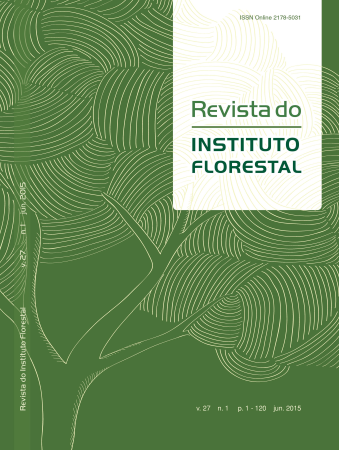MEASUREMENT OF BIOMASS IN PLANTATIONS OF Pinus elliottii Engelm
DOI:
https://doi.org/10.4322/rif.2015.008Keywords:
planted fores, forest management, adjustment of equations, modeling of forest biomassAbstract
This study aimed to quantify and model the biomass in Pinus elliottii Engelm. plantations, with different ages, in the city of Clevelândia, state of Paraná. The data for this study came from 25 forest stands aged 1-25 years totaling 125 trees, 5 for each age. Trees were felled and sectioned in the compartments: needles, live branches, dead branches, roots, reproductive structures, wood stem and bark stem. Then, a sample was taken of each component for obtaining dry matter. Ordination of biomass in the different components are distributed in the order: wood stem > root > bark > live branches > needles (photosynthetic structure) > dead branches and reproductive structure.Several mathematical models, among them models traditionally found in the forest literature, were adjusted in order to obtain estimates of biomass weight by dendrometric variables in different tree compartments. In general, the amount of biomass had good relations with the dendrometric variables resulting in satisfactory equations except for dead branches and reproductive structure components. The generated equations to estimate the total weight and arboreal components of the biomass in trees of Pinus elliottii Engelm. are important tools for technical analysis, project planning and feasibility studies for timber use
Downloads
References
BROWN, S.L.; SCHOEDER, P.; KERN, J.S. Spatial distribution of biomass in forests of the eastern USA. Forest Ecology and Management, v. 123, n. 1-3, p. 81-90, 1999.
FAN, S. et al. A large terrestrial carbon sink in North America implied by atmospheric and oceanic carbon dioxide models. Science, n. 282, p. 386-387, 1998.
INSTITUTO BRASILEIRO DE GEOGRAFIA E ESTATÍSTICA – IBGE. Manual técnico da vegetação brasileira. 2. ed. Rio de Janeiro, 2012. 274 p. (Série Manuais Técnicos em Geociências, n. 2).
KETTERINGS, Q.M. et al. Reducing uncertainty in the use of allometric biomass equations for predicting abovegroup tree biomass in mixed secondary forests. Forest Ecology and Management, v. 146, p. 199-209, 2001.
SEDJO, R. A. Temperature forest ecosystem in the global carbon cycle. Ambio, v. 21, p. 274-277, 1992.
WALKER, W. et al. Guia de campo para estimativa de biomassa florestal e estoque de carbono. Versão 1.0. Falmouth: Centro de Pesquisas Woods Hole, 2011. 72 p
















